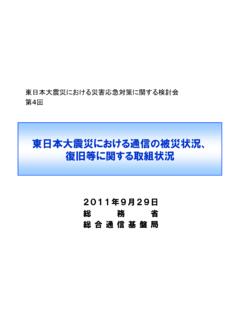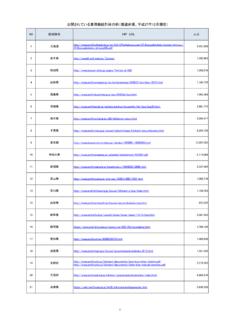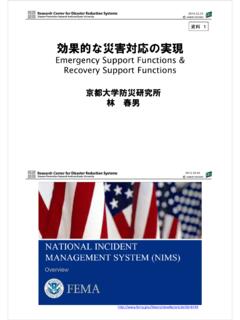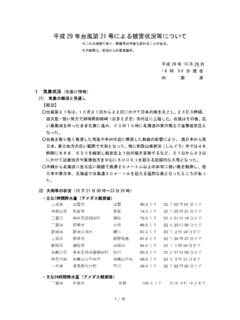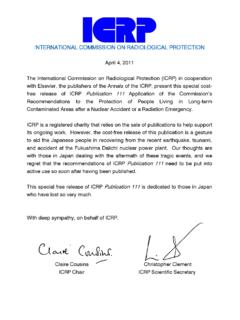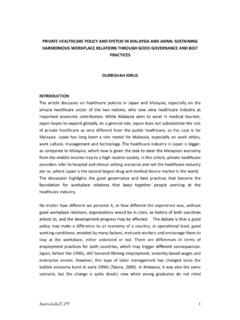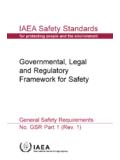Transcription of Business Continuity Guidelines - 内閣府防災担当
1 Business Continuity Guidelines Strategies and Responses for Surviving Critical Incidents Third Edition Cabinet Office, Government of japan Provisional Translation Notes on This Revision This is the second revision since the Guidelines were established in August 2005. In consideration of lessons learned from critical incidents threatening Business Continuity , the establishment of related institutions, changes in the economy and society, and so forth, these Business Continuity Guidelines Strategies and Responses for Surviving Critical Incidents are hereby announced. The following table shows the purpose and background of this revised version. Table (1): Background of Establishment and Revision of the Business Continuity Guidelines Date Purpose Background August 2005 To encourage enterprises to draw up a Business Continuity Plan (BCP) in case of disaster The importance of creating a BCP was noted in the Basic Recommendation of a Disaster Management Strategy by Utilizing Civil and Market Abilities (October 2004) which was prepared by the Council Special Board of Inquiry on Enhancing Disaster Management by Utilizing the Private Sector and Markets (established in September 2003).
2 The first version of the Guidelines was intended to spread the concept of BCP. November 2009 To make the Guidelines more practical The Study Panel on Measures to Facilitate the Establishment of a Business Continuity Plan conducted a study and revised the Guidelines to include the following: 1. Indication of relationship with other Guidelines 2. Indication of general applicability to all enterprises and organizations regardless of size, type of industry, or Business 3. Indication of the scope of Business risks for which Business Continuity efforts are effective 4. Emphasis on checks and corrective actions to improve and establish the Guidelines 5. Indication of Recovery Level Objective (RLO) which is inseparably linked with Recovery Time Objective (RTO) August 2013 To encourage the implementation of Business Continuity Management (BCM) by enterprises even in normal times To reflect the lessons learned from disasters, international trends, etc.
3 The Study Panel on Measures to Facilitate the Establishment and Operation of a Business Continuity Plan conducted a study and revised the Guidelines to include the following: 1. Indication of the necessity of implementing BCM even in normal times and improvement of related contents 2. Indication of the importance of including broad responses to risks and consideration of the supply chain, etc., and indication of the necessity of a flexible Business Continuity strategy for handling such risks 3. Indication of the importance of involvement by the management i Introduction As a result of the Great East japan earthquake in march 2011 , many enterprises in japan suffered serious damage from the massive tsunami and earthquake , and faced shortages of electricity, fuel, and so forth. Economic activities were affected not only domestically but also internationally through supply chains.
4 It is important to learn from this disaster and to prepare for other disasters that are likely to occur in the future. Without effective preparation, the Japanese economy and society may face a crisis if disaster strikes. Even in normal times, without effective preparation, there could be a loss of confidence in the Japanese economy, a slump in purchasing and direct investment from overseas, a shift of production bases to overseas, and so on. Therefore, enterprises in japan should consider all possible disasters which could hit japan or overseas, and prepare for the worst conceivable situations. They should constantly develop a Business Continuity strategy which can effectively handle the damage caused by a disaster, take countermeasures, and improve their efforts.
5 In some past disasters, some enterprises were able to restore normal operations quickly because their Business Continuity Plans or coordination with other companies worked effectively. Therefore, it is important for enterprises to utilize such lessons in order to enhance the capability to continue doing Business . As the Business operations and environments of enterprises become increasingly diverse and complicated, there is a risk that various critical incidents other than disasters could suspend production activities and distribution, causing severe impacts on society in japan and overseas. Therefore, it is necessary to build an economy and society which can be restored smoothly and seamlessly when the contingency happens. Thus, enterprises must improve their Business Continuity capabilities.
6 in japan , good Business Continuity practices have already been secured to some degree and have been proven to be effective in practice, and some of these practices in japan are more advanced than in other countries. Based on these experiences, enterprises should further improve their efforts. These Guidelines show the necessity of implementing good Business Continuity practices by enterprises in japan and describe what should be done, in order to facilitate the implementation of Business Continuity Management and hence create and improve Business Continuity Plans. Enterprises must take measures even in normal times in case they cannot continue important Business for some reason. They must know whether their actions are correct, since such actions may determine the success or failure of their Business /operation.
7 Therefore, the management should accept responsibility, understand the necessity and advantages of improving Business Continuity capabilities even in normal times, invest a reasonable amount of time, labor and money, be willing to continue doing Business under any adverse conditions, and strive to stay in Business . In addition, the management must publicize their efforts inside and outside the enterprise. The right decisions and management leadership are necessary when responding to contingencies. A Business Continuity initiative is a key task that the management should address. Responses by individual managers alone will be ineffective and the enterprise will be unable to fulfill its social responsibilities. These Guidelines provide advice to the management in Chapter : Requirements for Management and in Chapter VIII: Recommendations to the Management and the Economic Community.
8 We urge the management to read these chapters first. ii Table of Contents Notes on This Revision i Introduction ii Outline of These Guidelines 1 <Targets of these Guidelines > 1 <Purpose of these Guidelines > 1 <Incidents covered by these Guidelines > 1 <Status of these Guidelines > 2
9 <Composition of these Guidelines > 2 I Necessity and Outline of Good Practice in Business Continuity 3 Outline of Business Continuity Management 3 Relationship between Enterprises Conventional Disaster Management Activities and BCM 5 Necessity of Business Continuity Management 6 Requirements for Management 7 Whole Process of Business Continuity Management 8 II Establishment of Policy 9 Establishment of Basic Policy 9 Creation of a System for Implementing Business Continuity Management 9 III Analysis and Examination 10 Business Impact Analysis 10 Assessment of Impact of Business Interruption 10 Determination of Critical Operations and Examination of Recovery Time Objective/Recovery Level Objective 11 Identification of Key Elements and Bottlenecks
10 12 Analysis and Assessment of Risks 13 IV Examination and Finalization of Business Continuity Strategies and Measures 15 Basic Concept of Business Continuity Strategies and Measures 15 Examination of Business Continuity Strategies and Measures 16 Continuation or Early Recovery of the Supply of Critical Products and Services 16 Ensuring Core Functions of Enterprises 17 Measures in the Event that the Head Office Suffers a Disaster 18 Information Transmission 18 Maintenance of Information and Information Systems 18 Fund Procurement 19 Responses to Legal Regulations, etc.


